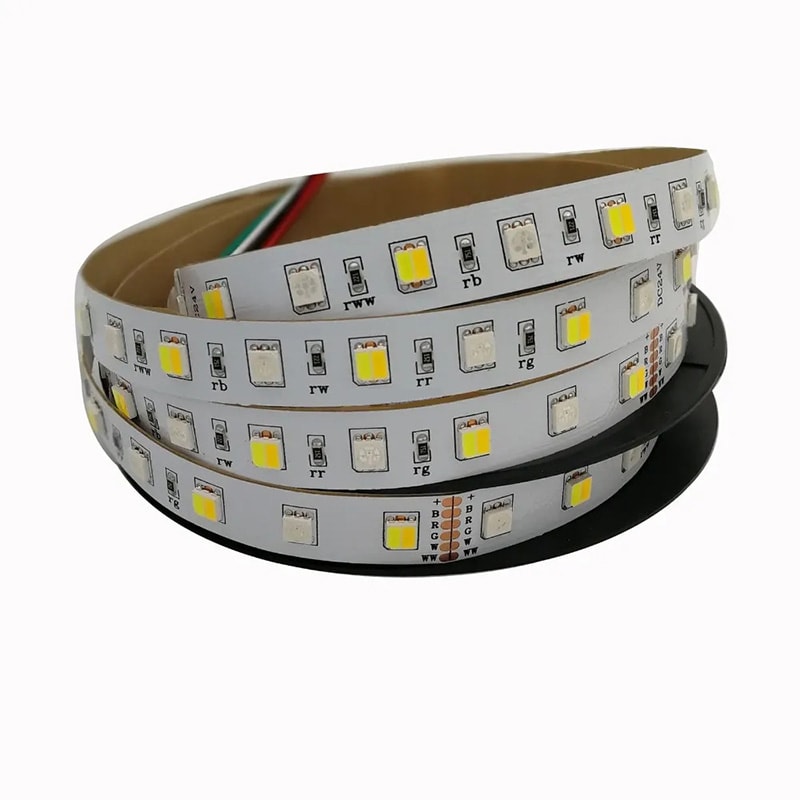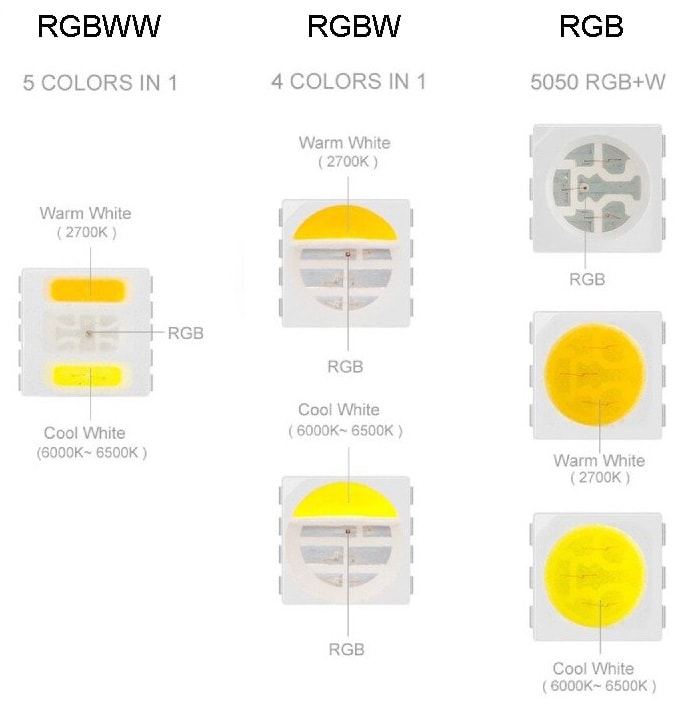Are you confused about RGB Vs. RGBW Vs. RGBWW LED Strip? What is the difference? Why are there so many? See below.
Table of Contents
The word LED stands for light emitting diode. RGB LEDs can be painted to your liking. The color of these diodes is indicated by the first letter of the color name. Therefore, the letters on an LED strip define the color of the light emitted and can completely change the color and quality of the light output.
What Does the Letter Mean on LED Strip?
What is the difference between RGB Vs. RGBW Vs. RGBWW LED strips? So, let’s first understand the abbreviations below.
RGB: A single three-channel LED chip with red, green, and blue diodes.
RGBW: A four-channel LED chip with Red, Green, Blue, and White diodes.
RGBWW: A four-channel chip with Red, Green, Blue, and Warm White.
What Is RGB LED Strip

RGB LED Strip
RGB light strips use three-channel (red, green, blue) LED chips. The range of RGB is 0-255. This means that RGB color mixing can create 16,777,216 colors (255*255*255).
For example, by setting the red and blue channels to zero (0) and the green channel to maximum (255), an RGB LED strip light displays green. Therefore, you can mix and create new colors by adjusting the red, green, and blue values in the LEDs.
The white color of the RGB strip is simulated by running all channels at 255 but is not pure enough.
What Is RGBW LED Strip

RGBW LED Strip
RGBW (RGB+white light) LED light strip uses red, green, blue and white four-in-one LED chips. RGBW strip lights add extra white chips to the color mix. So, in addition to the million hues produced by RGB, RGBW adds even more combinations with additional white chips.
RGB LED Strip can also produce white, why choose to add an additional white chip to RGBW? The answer is this. White in RGB is emitted by combining red, green, and blue. This white is not truly pure white. But with RGBW, you get pure white.
So, RGBW LED strips are more expensive than RGB because they contain different chips and offer more refined colors.
What Is RGBWW LED Strip

RGBWW LED Strip
RGBWW (RGB+white+warm white) LED strip uses red, green, blue, white and warm white five-in-one LED chips for color mixing. It can also be combined with a three-in-one RGB chip and two independent white and warm white LED chips.
The only difference between RGBW and RGBWW is the intensity of white. RGBWW lamps have an extra warm white color, producing color temperatures of 5,000 Kelvin and lower, creating a softer yellow-white color. Great for indoor lighting.
What’s the Difference: RGB Vs. RGBW Vs. RGBWW LED Strip Lights

RGB Vs. RGBW Vs. RGBWW LED Strip
Through several functional features, let us distinguish between RGB, RGBW, and RGBWW LED Strips.
| Products | RGB | RGBW | RGBWW |
|---|---|---|---|
| Colors | Red, Green, Blue | Red, Green, Blue, White | Red, Green, Blue, White, Warm white |
| Chips | 3 in 1 | 4 in 1 | 5 in 1 |
| Color Channels | 3 | 4 | 4 |
| Color Output | 16M(2653) | 4.3B(2654) | 4.3B(2654) |
| Color Shifting | Single | Single | Single |
| Brightness | Bright | Ultra-Bright | Ultra-Bright |
| Adjustable | – | ✔ | ✔ |
| Price | Normal | Medium | Expensive |
| Advantages | Lowest Cost | Brighter | Brighter & Warmer |
RGB vs. RGBW vs. RGBWW Differences Table
You can still visually see the difference between RGB Vs. RGBW Vs. RGBWW LEDs from the picture below.

RGB vs. RGBW vs. RGBWW LEDs
RGB Vs. RGBW
Differences Between RGB and RGBW LED Strips
1. Chip Configuration:
– RGB: A three-in-one chip featuring red, green, and blue diodes.
– RGBW: A four-in-one chip consisting of an RGB diode along with a separate white diode.
2. Color Variation:
– RGB LED Strips: Combines the three primary colors to produce approximately 16 million shade variations.
– RGBW LED Strips: The additional white diode in RGBW expands the range of color mixing possibilities.
3. Cost Comparison:
– RGB: Generally more cost-effective than RGBW due to the absence of the white diode.
– RGBW: The inclusion of the white diode increases the manufacturing cost, making RGBW slightly more expensive than RGB.
4. White Light Quality:
– RGB: The white hue produced by RGB LED strips is not pure white.
– RGBW: RGBW LED strips emit an accurate shade of white light, thanks to the dedicated white diode.
Choosing Between RGB and RGBW LED Strips
If Affordability is a Priority:
– For those seeking cost-effective LED strips, RGB is the preferable choice considering the differences mentioned above.
For Accurate White Lighting:
– If you require more precise white lighting, RGBW is the recommended option.
By considering these variations, you can make an informed decision based on your specific lighting needs and budget considerations.
RGB LED Strip Video Display
RGBW Vs. RGBWW
Comparing RGBW and RGBWW LED Strips
1. Chip Configuration:
– RGBW: Consists of four diodes within a single chip.
– RGBWW: Contains five diodes in a single chip, including white and warm white options.
2. White Diode Variation:
– RGBW: Equipped with one white diode.
– RGBWW: Features two white diodes, offering both white and warm white lighting options.
3. White Light Quality:
– RGBW: Provides pure and accurate white lighting.
– RGBWW: The white diode in RGBWW emits a warm (yellow) tone.
4. Price Comparison:
– RGBWW: Typically priced slightly higher than RGBW due to the additional warm white diode.
– RGBW: Offers a more affordable option compared to RGBWW.
Understanding the Distinctions Between RGBW and RGBWW LED Strips
When it comes to LED strips, there are notable differences between RGBW and RGBWW variants. These differences encompass the chip configuration, white diode options, white light quality, and pricing. By considering these factors, you can make an informed decision based on your lighting preferences and budget requirements.
RGBW LED Strip Video Display
Which is Better? RGB, RGBW or RGBWW LED Strip?
The better choice really depends on your actual needs and application.
If you only need basic RGB colors and don’t need pure white, then basic RGB LED strips are often more cost-effective and efficient.
If you need white and RGB colors and a mix of both, then RGB+W is a better choice.
But if you want to get different brightness of white. RGB+warm white+white would be a good choice. You can control the brightness of warm white and white. Dedicated white LEDs provide a purer white hue and allow you to choose additional warm or cool white chips.
How to Connect LED Strip Light: RGB Vs. RGBW Vs. RGBWW
Here are a few things you must keep in mind when connecting your LED strip.
- Step 1: Confirm whether yours is a 12V or 24V light strip.
- Step 2: Select the appropriate power supply. Make sure the power of the LED power supply is greater than the total power of the light strip and accessories.
- Step 3: Choose the correct LED strip cable. 3PIN, 4PIN, 5PIN or other.
- Step 4: Then connect the positive and negative terminals of the LED strip to the power supply.
- Step 5: Connect the other end of the power adapter to the power plug.
If you still don’t know how to do it, please watch the video below.
How to Connect LED Strip to A Power Supplier
Are The Controllers Different: RGB Vs. RGBW Vs. RGBWW
RGB, RGBW, and RGBWW LED Strip color changes and dimming is controlled by LED strip controllers. RGB, RGBW, and RGBWW LED Strip There are many options for selecting LED strip controllers.
RF LED controller
RF stands for radio frequency. This type of LED controller is relatively cheap. If you consider the cost budget, affordable RF LED controllers will be popular.
Infrared LED controller
Because the IR LED controller uses infrared light to control the range of 1-15 feet, you must control the distance if you choose an infrared LED controller.
Tunable white LED controller
This type of controller can give you the desired white brightness by adjusting the color temperature. For example, if you want to get warm white or cool white, you only need to adjust the color temperature. So, for tunable white, choose a tunable white LED controller.
Programmable LED controller
Programmable LED controllers offer DIY tinting options for custom colors. You can mix red, green, and blue in any ratio until you get the custom color you’re most happy with.
DMX 512 controller
If your project is a large-scale LED lighting project, it is recommended to choose the DMX 512 controller. The DMX512 controller can adjust the color of the LED along with the music. Suitable for large-scale lighting project sites such as concerts and light shows. DMX 512 LED controller, can also be synchronized with TV/Monitor.
0-10V LED controller
The 0-10V LED controller is a method of simulating light control by changing the voltage of the LED strip. Adjust the voltage to 0 volts for the lowest brightness, while 10V will produce the brightest output.
Wi-Fi LED Controller
Wi-Fi LED Controller is the easiest-to-use LED control system. By connecting the Wi-Fi connector to the LED strip (RGB/RGBW/RGBWW/RGBIC/RGBCCT), you can control the lights by connecting to your own smartphone.
Bluetooth LED controller
The Bluetooth LED controller is compatible with all LED strips. Connect the Bluetooth controller to the light strip and you can easily control the lights from your phone.
Therefore, when choosing an LED controller, you need to consider the effect you want to achieve. If you are confused and don’t know which LED controller to choose, please don’t hesitate to contact us to help you.
How to Choose Between RGB, RGBW, and RGBWW LED Strip Lights?
RGB LED strip lights are widely used and popular. However, for greater flexibility in lighting options, RGBW and RGBWW LED strips provide a wider range of choices. When selecting a colorful light strip, consider the following factors.
Cost:
In terms of price, RGB LED strips are the most affordable among RGB, RGBW, and RGBWW options. They offer a full spectrum of color combinations, making them a cost-effective choice.
Optional White:
For pure white lighting, RGBW LED strips are an excellent option. The “W” can represent either warm white or cool white, allowing you to choose the desired color temperature. RGBWW allows you to have more choices. Choosing different white color temperatures means more color effects. RGBW LED strips are reasonably priced, falling between RGB and RGBWW options.
Tunable:
If you require both white and colored lighting, consider RGB-CCT LED strips. They offer adjustable white color schemes along with red, green, and blue options. These LED strips provide 16 million RGB color variations and three RGBW options (RGBW, RGBWW, and RGBCW) in a single strip. Although they may be slightly more expensive, they offer the most comprehensive range of color options.
Functionality:
Select the LED strip that best suits your project requirements. If your project primarily focuses on colorful lighting and doesn’t demand high-quality white light, RGB LED strips are a suitable choice. They not only meet your project needs but also help you save costs.
Remember to consider your specific lighting preferences and project requirements when choosing the right LED strip for your needs.
FAQ
1. Can RGBW use an RGB LED controller?
-There are some situations where this is not possible. It is recommended that RGBW light strips are best paired with RGBW controllers.
2. Can RGBW LED strips be cut?
-Yes, same as the RGB LED strip. You can cut freely along the cutting line to customize the length you need.
3. Can RGBW be customized to warm white or true white?
-Yes, you can choose one of them. W Available in warm white or white depending on your needs.
4. Are RGB or RGBW lights harmful to your eyes?
-No, RGB lights will not directly harm your eyes but try to avoid looking at the lights for a long time.
5. What does WW mean in lighting?
-Warm White (WW) – 2700 to 3000K.
Natural White (NW) – 4000 to 4500K.
Cool White (CW) – 5000 to 6000K.
